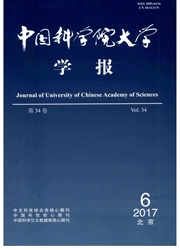

 中文摘要:
中文摘要:
丙烯和 5-hexenyl-9-borabicyclo 的共聚化合物[3.3.1 ] 壬烷(5-hexenyl-9-BBN ) 与 MgCl_2/TiCl_4 催化剂被进行了与 triethylaluminum (AIEt_3 ) 在有机性地修改的 montmorillonite (OMMT ) 设置了辅催化剂 anddiphenyldimethoxysilane (DDS ) 外部施主。这个聚合过程同时导致 MMT 层的脱落认识到 /MMTnanocomposites 和反应硼烷的培植在形成的 PP 矩阵组织的聚丙烯(PP ) 的准备。忍受 Thepolymer 的硼烷组能在很温和的反应条件下面经历一个有效水解作用过程(40 ℃, 3 h,在 THF ) ,没有牺牲形成聚合的 nanocomposite 结构(MMT 的脱落) ,介绍 hydroxy 组进 PP。resultanthydroxyl-functionalized PP/MMT nanocomposites 展览对基于 unfunctionalized PP 矩阵与那些相比处理提高了结构的稳定性。
 英文摘要:
英文摘要:
The copolymerization of propylene and 5-hexenyl-9-borabicyclo[3.3.1]nonane (5-hexenyl-9-BBN) has been conducted with an MgCl2/TiCl4 catalyst intercalated in an organically modified montmorillonite (OMMT) with triethylaluminum (AIEt3) cocatalyst and diphenyldimethoxysilane (DDS) external donor. This polymerization process simultaneously results in both the exfoliaUon of MMT layers to realize the preparation of polypropylene (PP)/MMT nanocomposites and the implantation of reactive borane groups in the formed PP matrix. The polymer-borne borane groups have been able to undergo an efficient hydrolysis process under very mild reaction conditions (40℃, 3 h, in THF), introducing hydroxy groups into PP without sacrificing the polymerization-formed nanocomposite structure (the exfoliation of MMT). The resultant hydroxyl-functionalized PP/MMT nanocomposites exhibit enhanced structural stability against processing compared with those based on unfunctionalized PP matrix.
 同期刊论文项目
同期刊论文项目
 同项目期刊论文
同项目期刊论文
 Synthesis of polypropylene block copolymers from brominated styrene-terminated isotactic polypropyle
Synthesis of polypropylene block copolymers from brominated styrene-terminated isotactic polypropyle Foaming behavior of polypropylene/ polystyrene blends enhanced by improved interfacial compatibility
Foaming behavior of polypropylene/ polystyrene blends enhanced by improved interfacial compatibility Conformation transition and crystalline phase variation of long chain branched isotactic polypropyle
Conformation transition and crystalline phase variation of long chain branched isotactic polypropyle 期刊信息
期刊信息
